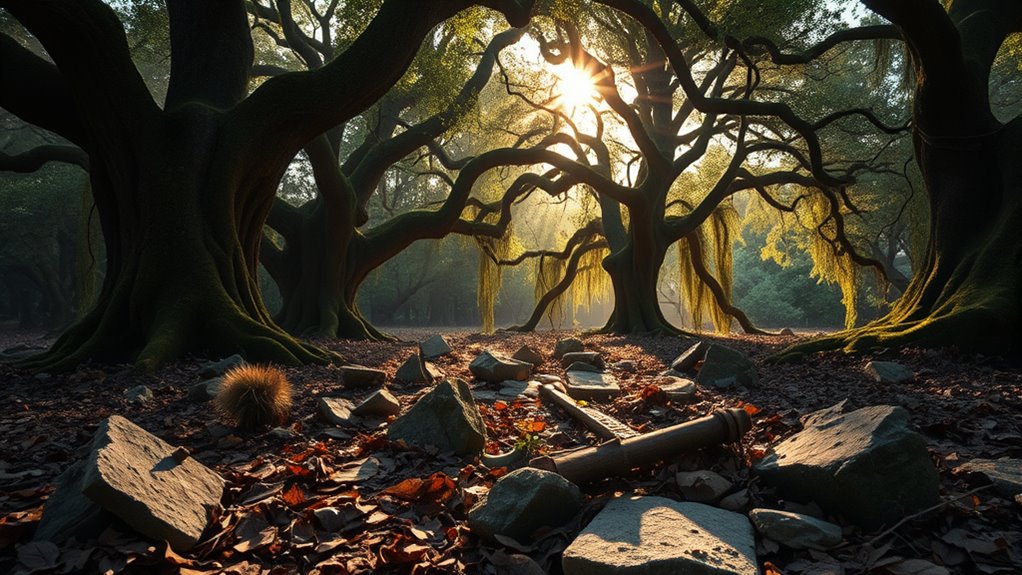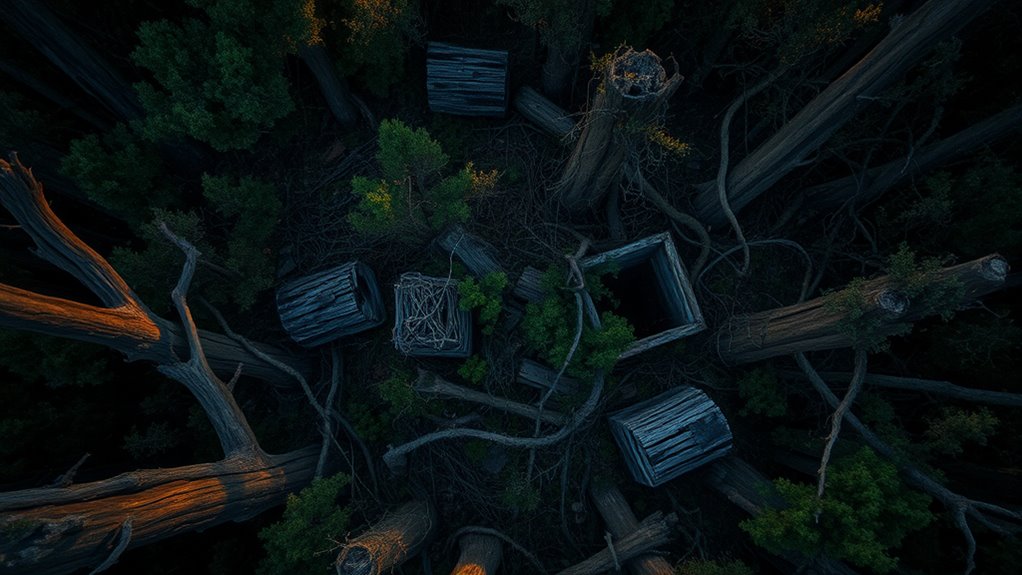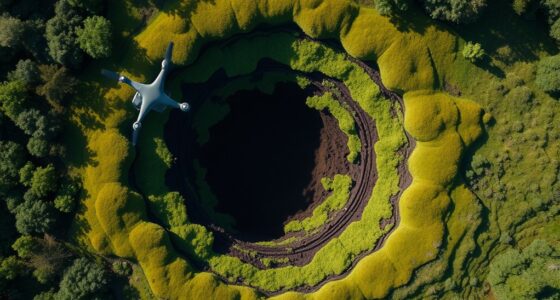Recent archaeological finds at the Roanoke site reveal new clues about what happened to the lost colonists. Artifacts like tools, pottery, and signs of Native American contact suggest the colony may have moved inland or integrated with local tribes. Advanced techniques help researchers analyze these relics more closely, sparking fresh theories. If you look further into these discoveries, you’ll uncover even more intriguing insights into this enduring mystery.
Key Takeaways
- Recent archaeological excavations have uncovered artifacts suggesting possible Native American interactions with the colonists.
- New findings point to potential inland relocation or integration of colonists with indigenous tribes.
- Advanced technologies are enabling more detailed analysis of relics, providing fresh insights into the colony’s fate.
- Some artifacts indicate conflicts or resource shortages that may have led to abandonment.
- Ongoing research continues to generate new hypotheses, keeping the mystery of Roanoke unresolved.

The Lost Colony of Roanoke remains one of the greatest mysteries in American history. As you explore this intriguing story, you quickly realize that it’s filled with unanswered questions that continue to fascinate historians and enthusiasts alike. The idea of a vanished settlement, seemingly swallowed by time, fuels countless theories and debates. Over the years, many have tried to uncover what happened to the colonists, and recent archaeological findings have added new pieces to this complex puzzle. These discoveries don’t give us definitive answers, but they do shed light on possible clues that could explain the colony’s disappearance.
Roanoke’s mystery endures, with recent archaeological finds offering new clues but no definitive answers.
The story of Roanoke is a prime example of colonial mysteries that continue to challenge archaeologists. For decades, researchers have searched for physical evidence of the settlement, hoping to find artifacts or structures that could tell us more about the lives of those early colonists. Recently, excavations near the original site have unearthed intriguing relics—tools, pottery, and even remnants of structures—that suggest a more complex picture than previously thought. Some findings point to the possibility that the colonists attempted to establish a sustainable community, while others hint at possible conflicts or hardships that might have led to their abandonment. These archaeological findings are vital because they provide tangible links to the past, allowing experts to piece together a more detailed narrative.
As you follow the trail of these recent discoveries, you see how each new piece of evidence sparks fresh theories. For example, some archaeologists propose that the colonists moved inland or integrated with local tribes rather than simply vanishing. Others believe they may have been caught in a conflict or forced to relocate due to resource shortages. The findings also include items that suggest contact with indigenous peoples, which could imply a different outcome than outright disappearance. Additionally, advances in archaeological techniques have enhanced the ability to analyze these relics in greater detail, opening new avenues for understanding the colony’s fate. While nothing conclusively proves what happened, these clues keep the story alive and continue to inspire new research. They remind us that history isn’t always clear-cut, and that sometimes, the truth is buried beneath layers of earth and time.
In the end, the archaeological findings at Roanoke are a tribute to the enduring mystery of this colonial settlement. They invite you to keep searching for answers, to question what might have been, and to appreciate the ongoing effort to unravel one of America’s oldest secrets. The story of Roanoke isn’t just about lost lives or abandoned buildings; it’s a reflection of the uncertainties that come with exploring our past, and the hope that someday, new discoveries will finally illuminate what truly happened to the lost colonists.
Frequently Asked Questions
Are There Any Living Descendants of the Roanoke Colonists?
You might be surprised, but some believe there are living descendants of the Roanoke colonists. Through genealogical research, people trace their ancestors’ steps, preserving their cultural heritage. While definitive proof remains elusive, family stories and DNA studies keep hope alive. If true, these descendants carry the legacy of the mysterious lost colony, connecting past and present in ways that feel almost magical.
What Modern Technologies Have Been Used to Investigate the Disappearance?
You can explore the disappearance using modern technologies like remote sensing, which helps locate buried artifacts or structures without digging. Additionally, genetic analysis allows you to examine DNA from remains or descendants to find clues about the colonists’ origins. These tools enable you to gather new evidence, offering insights into what happened to the Roanoke settlers and potentially solving the mystery of their disappearance.
Could the Colonists Have Moved Inland Rather Than Disappearing Entirely?
You might think the colonists simply vanished, but they could have moved inland instead. Evidence suggests colonist migration toward indigenous settlements or establishing inland settlements for safety and resources. While it’s tempting to believe they disappeared, it’s more likely they adapted and integrated with local tribes or found new opportunities farther from the coast. So, they may have gone underground, rather than truly disappearing into thin air.
How Do Theories About the Lost Colony Compare to Other Mysterious Disappearances?
You see, theories about the lost colony are some of the most intriguing colonial mysteries and historical enigmas. Unlike other disappearances, where evidence is scant, the Roanoke case sparks debate with clues like relocated settlements or conflicts with natives. You’re drawn to these stories because they challenge your understanding of early American history, making the disappearance a compelling puzzle that’s still unsolved, unlike many other mysterious events.
What Impact Did the Lost Colony Have on Native American Tribes?
You might not realize it, but the lost colony substantially impacted Native American tribes through shifting Native American alliances and cultural impacts. As European settlers arrived, tribes had to adapt to new relationships and pressures, altering their traditional practices and alliances. This upheaval influenced regional power dynamics and cultural exchanges. The colony’s disappearance added uncertainty, prompting tribes to reassess their strategies, ultimately shaping their histories and interactions with outsiders for generations.
Conclusion
As you explore the mystery of Roanoke, it’s fascinating to note that only about 115 settlers initially arrived, yet the fate of their entire community remains unknown. New clues suggest possible European or Native American involvement, but no definitive answers. This lingering question keeps the story alive, reminding you that history’s greatest puzzles often have the smallest details. Maybe someday, with more discoveries, you’ll finally uncover what happened to the lost colony of Roanoke.









